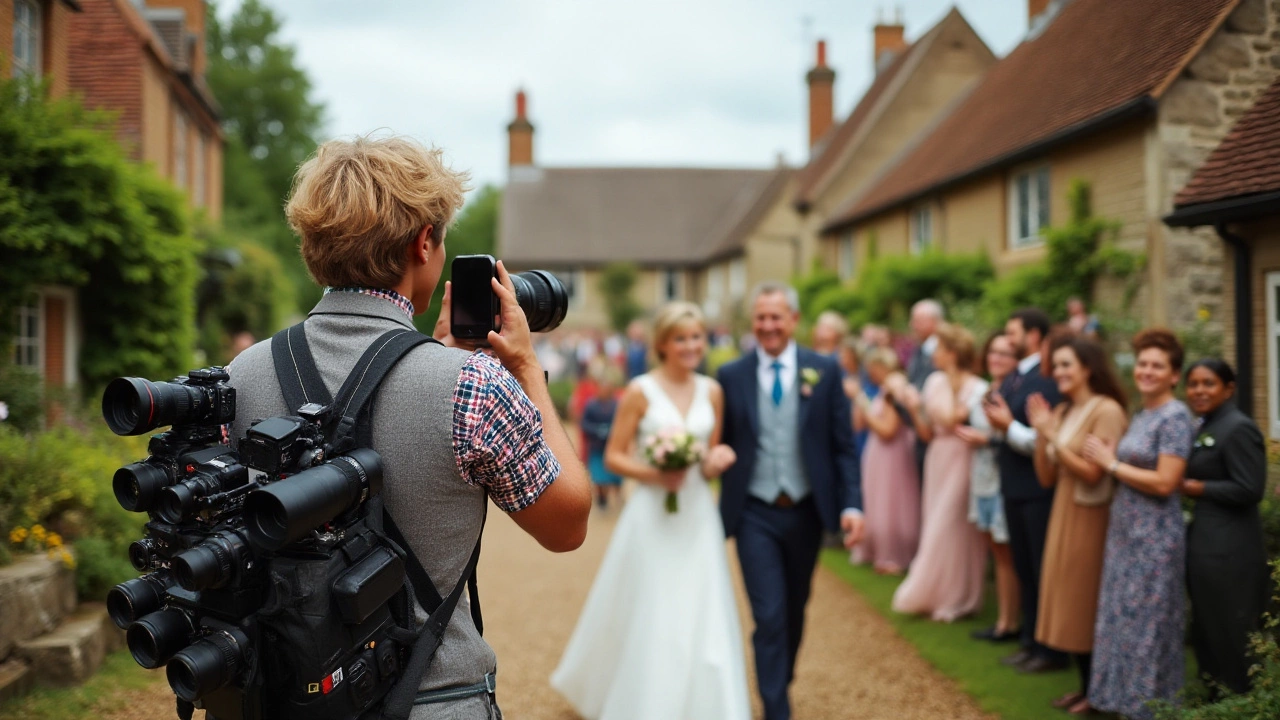Photographer Pricing Guide: Setting Rates for 3-Hour Weddings
 Nov, 24 2024
Nov, 24 2024
Setting the right price for wedding photography, especially for a concise three-hour session, involves much more than simply picking a number. It's a balance of understanding your expenses, your local market, and the value you deliver to the soon-to-be-wed couple.
Photography does not just capture moments; it tells a story, and pricing should reflect the artistry, skill, and dedication behind the lens. Whether you're capturing the day at a quiet beachside or in a bustling city hall, understanding how to price your services appropriately ensures your work is appreciated and sustainable.
We'll explore the vital aspects photographers should consider when determining rates, including how to factor in equipment upkeep, travel, editing, and communication. With the right approach, you'll not only meet your clients' expectations but also enrich your career as a wedding photographer.
- Understanding the Costs Involved
- Evaluating the Market
- Customizing Your Pricing Package
- Tips for Clear Communication with Clients
Understanding the Costs Involved
When setting a price for a wedding photography session, it's crucial to develop a clear understanding of all the costs you'll incur. Beyond the obvious time spent on the day itself, you should think about the extensive preparation and post-processing that enhances the value of your service. First, consider the substantial investment you've made in your equipment. High-quality cameras, lenses, lighting, and backup gear are not cheap, and their costs should factor into your pricing. These tools are, after all, the heart of your artistry, and maintaining them involves regular updates, cleaning, and occasional repairs, all of which add up over time.
Next, there is the cost of your software. Editing applications like Adobe Photoshop or Lightroom require subscriptions that can significantly impact your bottom line. The editing process itself is a meticulous labor of love and typically consumes several hours per session, meaning that you're not merely pressing a button. You're curating a gallery of moments that tell your clients' unique stories. This is time you have to account for in your fee structure.
Additionally, don't forget the less tangible, yet equally important, cost of your expertise. Your skills are honed through years of practice, education, and commitment to capturing beautiful moments. Seasoned photographers bring a wealth of experience, contributing to exceptional image quality and client satisfaction. Even for photographers new to the field, the cost isn't just about the photos but the experiences and stories encapsulated within each frame. As Joe Buissink, a renowned wedding photographer, once said,
"It's more important to click with people than to click the shutter."This illustrates how the personal connection and experience you offer are as valuable as the physical product.
Moreover, include administrative costs like insurance, marketing, website hosting, and continuous training to stay updated with trends and techniques in wedding photography. All these factors go into shaping a fair pricing model. Viewing your photography business holistically ensures that every aspect is adequately covered, allowing you to create a sustainable, successful business model that benefits both you and your clients.
To make it clearer, consider setting up a detailed cost breakdown chart. This could include average costs such as:
- Equipment maintenance: 15% of annual income.
- Software licensing: USD 50 - 100 per month.
- Insurance and liabilities: USD 200 - 500 annually.
These calculations serve as a guideline to ensure that each photography session is priced appropriately, reflecting all the facets of your work. Keeping these in mind will help you develop a rate that honors your talent and keeps your business thriving.

Evaluating the Market
Before settling on your pricing, it's crucial to delve into an evaluation of the market where you intend to offer your wedding photography services. This means conducting a thorough analysis of competing photographers in your area. Understanding their pricing structures, service offerings, and the quality of work can help you position your services effectively. A vital step is to analyze current trends in the industry by exploring local wedding forums, social media platforms, and attending bridal fairs. These gatherings are treasure troves for gleaning insights into what potential clients are seeking and willing to pay for.
The local economy also plays a pivotal role in shaping your price points. In economically thriving cities, there might be a higher threshold for wedding photography expenditure. Conversely, in areas where economic conditions are less favorable, setting a higher price might alienate potential clients. Balance is key, and setting a price that reflects both the value of your work and aligns with market expectations is essential.
As renowned photographer Annie Leibovitz once said, 'A thing that you see in my pictures is that I was not afraid to fall in love with these people.' This connection you build with your clients is priceless and often what sets you apart in a competitive market.
Consider also the specific demand for different types of wedding photography. There could be a niche that hasn't been extensively captured. For instance, if you notice a rising trend in intimate beach weddings or city hall ceremonies, tailoring packages that cater to these events could differentiate you in the marketplace. Often, couples are looking for something unique or specific, and tapping into these nuances can enhance your appeal. Keep an eye on the seasonality within your region too; wedding seasons can vary, impacting how you strategize your pricing model across the calendar year.
Understanding your target audience is another layer of evaluating the market. This involves segmenting your potential clients by demographics and psychographics—age, socioeconomic status, lifestyle preferences, and even wedding themes they are inclined towards. Surveys and direct client interviews can offer invaluable insights into their preferences. With this data in hand, adjust your marketing and pricing strategies accordingly to strike the right chord with those most likely to book your services.
For a data-driven insight, you might compile statistics about average wedding photography costs in your local area. For example, a study might reveal that urban settings like Melbourne have a median wedding photography charge of $2,500 for a full day. Using such figures as a benchmark can help refine your pricing for shorter three-hour sessions. While it is tempting to set your fees below market average to attract more clients, ensure that the price is sustainable and reflects the value you offer—your unique style, service quality, and personal touch.

Customizing Your Pricing Package
Wedding photography is as unique as the couples coming together, which is why creating a nuanced pricing package can set you apart from the sea of options. Customizing your package begins with understanding that you're not just offering hours of service; you’re selling an experience that immortalizes fleeting emotions and moments. When you're shaping a pricing package, it's crucial to first identify your expertise level and the specific services you can provide, like pre-event shoots or high-end album creations.
A good start to customizing involves tiered packages that offer varying levels of service; each level can escalate with added benefits like an additional photographer, rapid delivery of edited images, or a custom photo album. Consider researching what's popular locally, as preferences vary significantly by region. For instance, in some markets, digital-only packages might be the norm, while others demand printed albums or specialized shoots like engagement or bridal sessions. Tailoring your packages helps keep you competitive in the wedding photography pricing space.
When structuring these packages, you also have to be clear about what each entails. Clients benefit from transparency—know exactly what they’re paying for, including the number of photos, delivery method, and timeframe. A fair approach may be to itemize parts of your package, which can include travel costs, especially if weddings are outside your typical area. Never underestimate the power of a few testimonials or samples linked within your offer details. This transparent approach hasn’t just worked well for photographers but across other service-based professions. A famous saying in the industry encapsulates this strategy:
"Pricing packages make it possible to find harmony between expectation and budget while emphasizing the quality," as noted by veteran photographer John Smith of the Photography Guild.
Moreover, it’s beneficial to offer a la carte add-ons. This allows potential clients the flexibility to tailor the package further according to their preferences and budget. Such items might be additional hours of coverage, wedding videography collaboration, or drone footage. Emphasizing such flexibility not only entices those with specific needs but often encourages higher spending on select services they truly value.
Interestingly, studies show couples tend to appreciate the perceived value more when packages are straightforward and seem personalized to their needs. This strategy is backed by data showing that 60% of couples are willing to spend more on personalized services that reflect their journey. Consider compiling the packages in a stylized brochure or a concise PDF that aligns with your brand’s aesthetics. Ultimately, a well-crafted pricing package is one that neither undersells your talent nor prices out potential clients who would cherish your unique photographic eye.

Tips for Clear Communication with Clients
As a wedding photographer, establishing a strong line of communication with your clients is not just a nicety—it's a necessity. The success of a three-hour wedding shoot not only hinges on your technical ability behind the camera but also on how well you understand the couple's vision and expectations. Clear communication helps avoid misunderstandings and ensures you deliver exactly what the clients are dreaming of for one of their most important days.
One effective way to start the conversation is by asking questions that illuminate the couple's priorities. Do they envision candid shots amidst the laughter of their guests, or are they more interested in posed pictures with their nearest and dearest? This initial interaction is crucial for tailoring your services to match their needs. Having a well-structured questionnaire ready can be beneficial, providing you with insights into their desired style and key moments they wouldn't want to miss.
Transparency about your pricing is equally essential. Be upfront about your rates, what they include, and what could incur additional costs, like travel beyond a certain radius or edits beyond a specific number of images. Providing a comprehensive breakdown not only prevents future disputes but also builds trust and reassures clients they are getting value for their investment. Consider creating a detailed pricing guide that explains exactly what they can expect for the three-hour wedding coverage. This can be shared via email or accessed on your website.
Remember, good communication is not just about talking; it's also about listening. Pay close attention to feedback and be responsive both before and after the gig. Regular updates leading up to the wedding day can ease any anxieties from your clients' side, making sure all parties are on the same page. Post-wedding, keep them informed about the timeline of when they'll receive their cherished memories. The reassurance alone can make a huge difference in client satisfaction.
It can also be beneficial to set up a virtual or in-person pre-wedding meeting, where you can discuss the schedule, share ideas, and clarify any doubts they might have. Adding personal touches, like suggesting favorite spots for particular shots based on venue familiarity, can elevate the client experience. This preparation phase is where you can establish yourself not just as a service provider, but as a supportive partner in their wedding journey.
Feedback after delivering the final product is another touchpoint that shouldn't be overlooked. Encouraging clients to share their opinions allows for continuous improvement in your services, and satisfied clients are likely to recommend you to others. In a digital age, an online review can be as good as gold. According to a survey by The Knot, 34% of couples found their photographer by reading online reviews, showing the enormous potential ripple effect of delighted customers.
"The key to great client communication is clarity, consistency, and care," says renowned photographer Jasmine Star. "It can turn a regular transaction into a memorable experience."
Implementing these strategies can create a seamless experience not only for your clients but also for you, allowing your artistry to shine without the shadow of miscommunication looming overhead. After all, preserving the joy, love, and laughter of a wedding day as a wedding photographer is as much about understanding emotion as it is about capturing it on film.